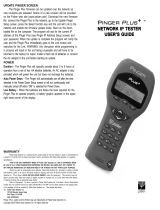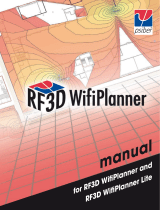Page is loading ...

SAFETY
The LanMaster 20 has internal circuit protection
to prevent damage if plugged into typical telephone
circuits. The protection circuit can withstand 48Vdc
from a source impedance of 600 ohms for 15 seconds.
When connected to an unknown RJ-45 port and testing
shows a “NO LINK” condition, the unit should be
disconnected within 15 seconds.
WARRANTY
Psiber Data Systems Inc. warrants that the product shall be free
from defects in parts or workmanship for a period of 12 months from the
date of purchase if used in accordance with Psiber Data Systems Inc.
operating specifications.
THIS IS THE ONLY WARRANTY MADE BY Psiber Data Systems
Inc. AND IS EXPRESSLY MADE IN LIEU OF ALL OTHER WARRANTIES
EXPRESSED OR IMPLIED, INCLUDING BUT NOT LIMITED TO ANY
IMPLIED WARRANTIES OF MERCHANTABILITY OR FITNESS FOR
ANY PARTICULAR PURPOSE.
Should any parts or workmanship prove defective, Psiber Data
Systems Inc. will repair or replace at Psiber Data Systems’ option, at no
cost to the Buyer except for shipping costs from the Buyer’s location to
Psiber Data Systems Inc. This is Buyer’s SOLE AND EXCLUSIVE
REMEDY under this Agreement.
This warranty does not apply to products which have been subject
to neglect, accident or improper use, or to units which have been altered or
repaired by other than a Psiber Data Systems Inc. authorized repair facility.
Return of Equipment - To return a product to Psiber Data Systems
Inc., first obtain a Return Authorization number from our Customer Service
by calling 619-287-9970. The RA# must be clearly marked on the shipping
label, or the package will not be accepted by Psiber Data Systems Inc.
See sample label below.
To: Psiber Data Sytems Inc.
7075-K Mission Gorge Road
San Diego, CA 92120
RA# XXXXXXXX
LanMaster, psiber and the Psiber logo are trademarks of Psiber Data
Systems Inc. Copyright 1998 Psiber Data Systems Inc. All rights reserved.
Part No. 1005-0000-0002 Rev B
LL
LL
L
ANAN
ANAN
AN
MM
MM
M
ASTERASTER
ASTERASTER
ASTER
20 20
20 20
20
USERS GUIDE

BOX CONTENTS
• LanMaster 20 Link Tester • RJ-45 Coupler
• 9 Volt Alkaline Battery • User Guide
BATTERY
The LanMaster 20 operates on one 9 volt alkaline
battery. Remove the battery cover
at the bottom of the unit and insert
the battery with the terminal
orientation as shown. Battery
polarity is marked on the back of
the battery cover and inside the
battery well for reference.
TECHNICAL OVERVIEW
The IEEE 802.3u Standard for 100baseTX (Fast
Ethernet) requires LAN equipment to use a signaling
system to establish a Link between two devices called
Link Partners. Standard Ethernet uses a single Normal
Link Pulse to establish the Link. Fast Ethernet
equipment (and some recent 10baseT products) use a
burst of Fast Link Pulses(FLPs) to transmit a Link Code
Word defining the configured capabilities of the device
and to report faults . If both Link Partners have Auto-
negotiation capability, a Link is established based on
the following priority:
1. 100baseTX Full Duplex
2. 100baseT4
3. 100baseTX Half Duplex
4. 10baseT Full Duplex
5. 10baseT Half Duplex
The IEEE 802.3u Standard does not require Fast
Ethernet equipment to support Auto-negotiation or more
than one 100baseT mode of operation. New and
installed equipment can have different levels of support
for Fast Ethernet features. Additionally, these features
can be manually configured during installation or
operation. The LanMaster 20 detects and decodes the
Link signals on Standard and Fast Ethernet networks
and displays the equipment configuration and reported
faults. The LanMaster 20 does not test 100baseT4.
OPERATION
Insert the LanMaster plug end in to the RJ-45 port
of a hub, switch, network interface card, wall outlet, or
attach to a UTP or STP cable with the RJ-45 coupler
and press the “TEST” button. Wire pair 3,6 (Link signals
from the network) is scanned for two seconds. If Link
signals are detected, the indicator(s) for the operational
modes or fault condition are illuminated and testing is
complete. When no signals are detected on the first
wire pair, the unit scans wire pair 1,2 (Link signals from
the node) for two seconds. Link signals are decoded
and the indicator(s) for the modes or fault are lit. If no
signals are detected, “NO LINK” is illuminated.
When two or more
operational mode indica-
tors are activated, the Link
being tested is capable of
Auto-negotiating to the
highest common level of
operation when a Link
Partner is installed.
APPLICATIONS
Network Planning - Identify capabilities of installed
equipment for LAN upgrades without opening the case.
Installation - Verify physical layer connectivity to the far
end. Testing should be run from each end of a Link to
verify two way continuity.
Trouble Calls - Reduce troubleshooting time by
ensuring the Link is active and no faults are detected.
Moves, Adds and Changes - Verify Link is operating
after punching down new connections.
Network Management - Test current configuration of
installed equipment to determine if features or modes
have been configured manually.
/



